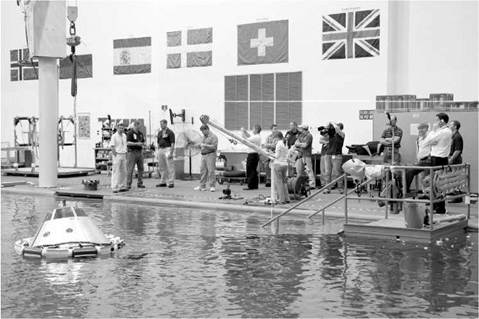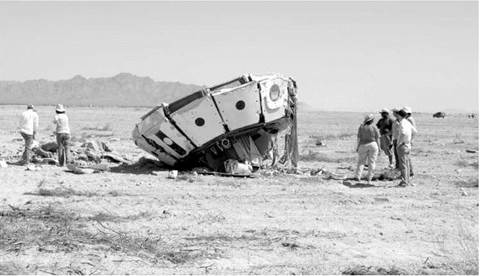Landing methods
Having completed their mission crews prepare for the return to Earth. The method of crew recovery depends upon the design of the vehicle and the location of the landing area. This is usually a barren expanse of land or one of the planet’s vast oceans, both of which give a wide margin for error. The occupants of the spacecraft always hope for a safe and as soft a landing as possible.
For the Soviets, and subsequently the Russian planners, the preferred landing site has always been on soil, usually the immense expanse of Kazakhstan. One of the main reasons for this in the early days was the then secret nature of the whole
|
Water impact for Orion mock-ups. |
|
Land impact tests for Orion revealing the planned dual landing capability. |
Soviet space project; keeping the returning crews and vessels away from the eyes of the outside world. It also avoided diverting naval resources into recovering crews from distant oceans. The early Vostok missions were unable to support a returning cosmonaut landing inside the spacecraft and thus provided an ejection seat for separate parachute descent. However, since 1964 all returning Soviet/ Russian spacecraft with a human crew on board have featured retro-rockets to soften the impact on the arid steppe land.
All Soyuz crews train for water recovery and, though none have been planned, there was one “splashdown”, on a frozen lake in 1976. The recovery proved to be a challenge for both the crew on board and the rescue teams. An earher mission also just missed landing in a lake by just 50 meters in 1971. With the advent of international cooperation, a number of international backup landing sites have been established for Soyuz spacecraft emergency landing situations, foremost of which are sites in Canada.
The ground landing is commonly called a “dust down”. Also termed a “soft landing” method, a landing in a Soyuz is never “soft”, with some dramatic impacts reported over the years, and with spacecraft bouncing upon landing or dragged by parachute. Crews have frequently described the impact as similar to a car crash. The earlier Vostok missions were also planned with ground landings, although cosmonaut training included water recovery techniques as a precaution. But with Vostok, the landing speed of the capsule was higher than any crew would have been able to survive, so the solo cosmonaut used an ejection seat system to vacate the capsule and descend by personal parachute.
One problem that this caused was in officially verifying the early missions. The Soviets had to state officially that each cosmonaut had launched and landed in their spacecraft in order to qualify for the new, internationally recognized aeronautical record. One of the criteria for this was that an occupant had to be inside the vehicle from the moment of leaving the pad to it touching down back on Earth. The Soviets quietly had to ignore this, particularly for Gagarin’s first mission, and maintained this pretense until 1978 when reports emerged that the first cosmonaut had indeed used the ejection system and parachute at the end of his flight. By then, of course, it hardly mattered.
When the Vostok was “upgraded” to fly a larger crew the ejector seat was removed. But this brought back the problem of the higher landing velocity and no suitable escape system. It was for these Voskhod craft that the retro-rocket package was first introduced, located in the recovery parachute system to slow the descent enough for the crew to survive the landing. Fortunately, only two Voskhod were flown, so the risk was minimal before the advent of Soyuz. The Chinese Shenzhou is similar to Soyuz. It is also designed for ground landings and follows a similar profile to the Russian craft.
All American manned space flights under Mercury, Gemini, and Apollo ended with parachute recoveries in the ocean and were retrieved with the assistance of the U. S. Navy. This costly exercise was one of the reasons the Shuttle vehicle was designed with ground landings in mind, reducing NASA’s bill from the U. S. Navy. The possibility of an orbiter ditching on water was still feasible in emergency situations and all crews did train for water egress up to the vehicle’s retirement. Conversely, land recovery techniques were also studied for both Gemini and Apollo although it was never adopted beyond tests and demonstrations. The vehicles currently in development to replace the Shuttle are being designed with both land and water-landing capabihties in mind.
From 1981 through 2011, 133 of the 135 Shuttle missions launched ending with a landing inside the continental United States, on runways in Florida (78 landings), California (54 landings), or New Mexico (1 landing). The Shuttle also had the capacity to land at a number of contingency landing sites around the world, although these were never called upon. Neither were the various transatlantic landing sites that were on standby during each launch in case the mission was terminated early. The Shuttle also had the capacity (in theory) to return to its launch site if necessary in an emergency situation, but again this was never required, much to the relief of each Shuttle crew!












